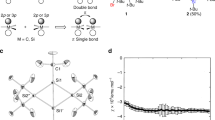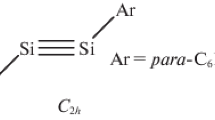Abstract
The substituent effect was analyzed on the binding energy of 2p-electrons of the silicon atoms estimated by the X-ray electron spectroscopy or calculated by quantum chemistry method for 15 series of organosilicon compounds. It was established for the first time that the binding energy depended not only on the inductive and resonance effects of the substituents, but also on the polarization effect consisting in the electrostatic interaction of the positive charge on the silicon atom with the dipoles which this charge induced in the substituents. The contribution of the polarization effect reached 35%.
Similar content being viewed by others
References
Karlson, T.A., Fotoelektronnaya i Ozhe-spektroskopiya (Photoelectron and Auger spectroscopy), Leningrad: Mashinostroenie, 1981.
Jolly, W.L., Bomben, K.D., and Eyermann, C.J., Atom. Data. Nucl. Data., 1984, vol. 31, p. 433.
Nefedov, V.I., Rentgenoelektronnaya spektroskopiya khimicheskikh soedinenii (X-ray Electron Spectroscopy of Chemicals), Moscow: Khimiya, 1984.
Nefedov, V.I. and Vovna, V.I., Elektronnaya struktura organicheskikh i elementoorganicheskikh soedinenii (Electron Structure of Organic and Elementorganic Compounds), Moscow: Nauka, 1989, p. 199.
Segala, M., Takahata, Y., Chong, D.P. J. Electron Spectr., 2006, 151, p. 9.
Perry, W.B., Jolly, W.L. Inorg. Chem., 1974, 13, p. 1211.
Drake, J.E., Riddle, C., and Coatsworth, L., Canad. J. Chem., 1975, vol. 53, p. 3602.
Drake, J.E., Riddle, C., Henderson, H.E., and Glavincevski, B., Canad. J. Chem., 1976, vol. 54, p. 3876.
Drake, J.E., Riddle, C., Glavincevski, B., Gorzelska, K., and Henderson, H.E., Inorg. Chem., 1978, 17, p. 2333.
Kelfve, P., Blomster, B., Siegbahn, H., Siegbahn, K., Sanhueza, E., and Goscinski, O., Phys. Scripta., 1980, vol. 21, p. 75.
Lindgren, I., J. Electron, Spectr., 2004, vols. 137–140, p. 59.
Egorochkin, A.N., Kuznetsova, O.V., and Khamaletdinova, N.M., Zh. Obshch. Khim., 2008, vol. 78, p. 1146.
Khamaletdinova, N.M., Egorochkin, A.N., Kuznetsova, O.V., Zh. Obshch. Khim., 2009, vol. 79, p. 1680.
Egorochkin, A.N., Voronkov, M.G., Zderenova, O.V., and Skobeleva, S.E., Izv. Akad. Nauk, Ser. Khim., 2001, p. 41.
Termodinamicheskie svoistva individual’nykh veshchestv (Thermodynamic Properties of Individual Substances), Glushko, V.P., Moscow: Izd. Akad. Nauk SSSR, 1962, p. 2.
Kebarle, P. and Chowdhury, S., Chem. Rev., 1987, vol. 87, p. 513.
Egorochkin, A.N., Kuznetsova, O.V., and Novikova, O.V., Zh. Obshch. Khim., 2007, vol. 77, p. 68.
Exner, O., Correlation Analysis of Chemical Data, New York: Plenum Press, 1988, p. 275.
Egorochkin, A.N. and Voronkov, M.G., Elektronnoe stroenie organicheskikh soedinenii kremniya germaniya i olova (Electron Sctructure of Peganic Compounds of Silicon, Germanium, and Tin), Novosibirsk: Izd. Sib. Otd. Ros. Akad. Nauk, 2000, p. 615.
Taft, R.W. and Topsom, R.D., Prog. Phys. Org. Chem., 1987, vol. 16, p. 165.
Egorochkin, A.N., Voronkov, M.G., and Kuznetsova, O.V., Polyarizatsionnyi effekt v organicheskoi elementoorganicheskoi, i koordinatsionnoi khimii (Polarization Effect in Organic, Elementorganic, Coordination Chemistry). Nizhni Novgorod: Izd. Nizhegorod. Gos., Univ., 2008, p. 336.
Janesko, B.G., Gallek, C.J., and Yaron, D., J. Phys. Chem. A, 2003, vol. 107, p. 1655.
Pacey, P.D. and Tan, Q.-T.N., J. Phys. Chem., 1995, vol. 99, p. 17729.
Hansch, C., Leo, A., and Taft, R.W., Chem. Rev., 1991, vol. 91, p. 165.
Takahata, Y. and Chong, D.P., J. Electron, Spectr., 2003, vol. 133, p. 69.
Segala, M., Takahata, Y., and Chong, D.P., J. Mol. Struct. THEOCHEM., 2006, vol. 758, p. 61.
Author information
Authors and Affiliations
Corresponding author
Additional information
Original Russian Text © N.M. Khamaletdinova, O.V. Kuznetsova, A.N. Egorochkin, 2009, published in Zhurnal Organicheskoi Khimii, 2010, Vol. 46, No. 2, pp. 175–182.
Rights and permissions
About this article
Cite this article
Khamaletdinova, N.M., Kuznetsova, O.V. & Egorochkin, A.N. Binding energy of 2p-electrons of silicon atom. Substituents effects in Si-centered cation-radicals. Russ J Org Chem 46, 166–173 (2010). https://doi.org/10.1134/S107042801002003X
Received:
Published:
Issue Date:
DOI: https://doi.org/10.1134/S107042801002003X




